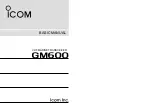
MDS 05-4055A01, Rev. A
MDS entraNET 900 System Guide (Preliminary)
9
In a point-to-multipoint scenario, the Access Point services multiple
remotes. A problem in the Access Point will have an effect on all
remotes, since none will have access to the network. When operation of
the network does not tolerate any down time, it is possible to set up a
protected configuration for the Access Point to greatly reduce the possi-
bility of this happening.
Two or more Access Points can be configured with the same Network
Name and kept active simultaneously, each with its own independent
antenna. In this scenario, Remotes will associate with either one of the
available Access Points. In case of a failure of one of the AP’s, the
Remotes will quickly associate with another of the remaining Access
Points re-establishing connectivity to the end devices.
Access Points are unaware of the existence of another co-located AP.
This is because the hopping algorithm uses
both
the Network Name
and
the Wireless MAC address of the AP to generate the hopping pattern.
For this reason, multiple AP’s can coexist—even if they use the same
network name. The co-located AP’s will be using different hopping pat-
terns and frequencies the great majority of the time. Although some col-
lisions will occur, the wireless-MAC is built to tolerate and recover from
such occurrences with minimal degradation.
1.3.3 Co-locating Multiple Networks
Many wireless networks can operate in relatively close physical prox-
imity to one another providing reasonable measures are taken to assure
the radio signal of one Access Point is not directed at the antenna of the
second Access Point.
The Network Name and the association process
The Network Name is the foundation for building individual
MDS entraNET 900 networks. It is part of a beacon signal broadcast by
the Access Point (AP) to any Remote units with the same Network
Name. Remotes that join the network are referred to as being “associ-
ated” with the Access Point unit.
Multiple APs with the same Network Name should be avoided unless a
redundant system is being deployed. Using the same Network Name in
multiple APs may result in Remotes associating with undesired APs and
preventing data exchange from occurring.
The use of a different Network Name does not guarantee an interfer-
ence-free system. It does however, assure that only data destined for a
unique network is passed through to that network.
Co-Location for
Redundancy
You can co-locate Access Points at one location for load-sharing or
redundancy, provided they have the same Network Name. Provide some
vertical separation between the antennas to minimize RFI between
them.
Summary of Contents for MDS entraNET 900
Page 2: ......
Page 8: ...vi MDS entraNET 900 System Guide Preliminary MDS 05 4055A01 Rev A ...
Page 10: ...2 MDS entraNET 900 System Guide Preliminary MDS 05 4055A01 Rev A ...
Page 82: ...74 MDS entraNET 900 System Guide Preliminary MDS 05 4055A01 Rev A ...
Page 84: ...76 MDS entraNET 900 System Guide Preliminary MDS 05 4055A01 Rev A ...
Page 92: ...84 MDS entraNET 900 System Guide Preliminary MDS 05 4055A01 Rev A ...
Page 94: ...86 MDS entraNET 900 System Guide Preliminary MDS 05 4055A01 Rev A ...
Page 108: ...100 MDS entraNET 900 System Guide Preliminary MDS 05 4055A01 Rev A ...
Page 110: ...102 MDS entraNET 900 System Guide Preliminary MDS 05 4055A01 Rev A ...
Page 122: ...114 MDS entraNET 900 System Guide Preliminary MDS 05 4055A01 Rev A ...
Page 139: ...MDS 05 4055A01 Rev A MDS entraNET 900 System Guide Preliminary 131 ...
Page 140: ...132 MDS entraNET 900 System Guide Preliminary MDS 05 4055A01 Rev A ...
Page 148: ...140 MDS entraNET 900 System Guide Preliminary MDS 05 4055A01 Rev A ...
















































